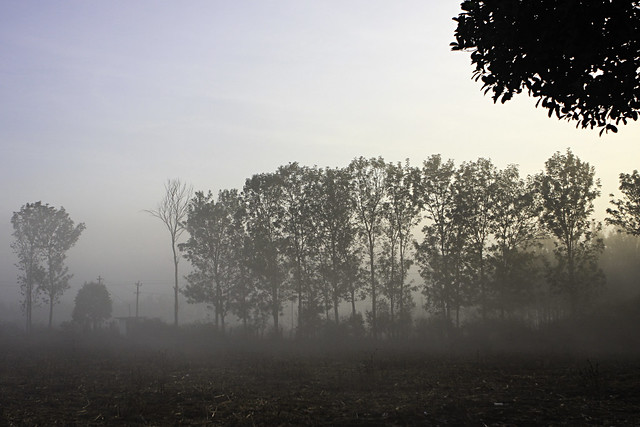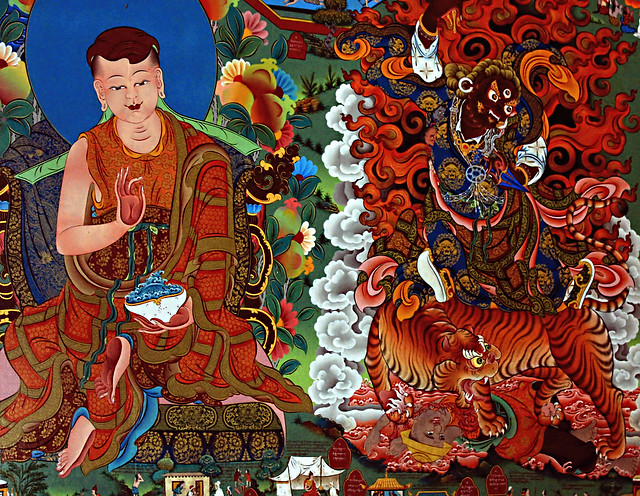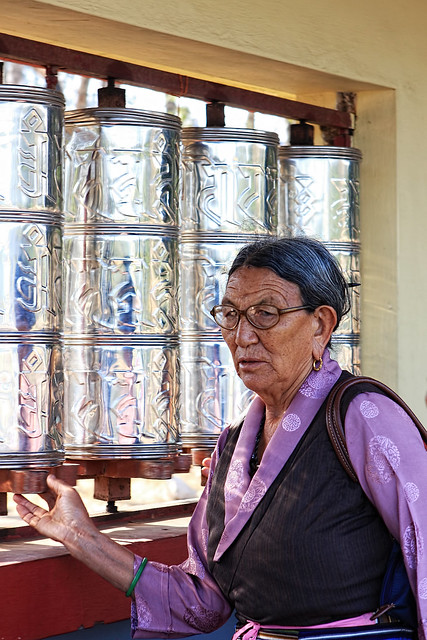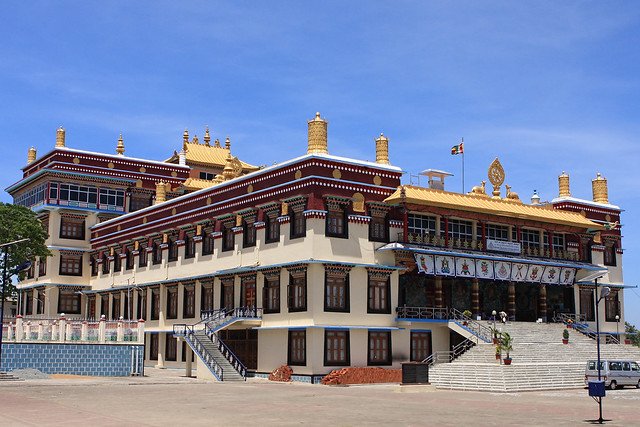It wasn’t dawn yet as we got off the bus. The bus station seemed quite desolate in the wee small hours of morning. Though mid-March, early morning temperatures were still on the lower side. And unfortunately for us, the bus had been early, contrary to the norm. Hanging around didn’t seem a good idea. A short walk across the road took us to a modest looking hotel and we decided to get some shut-eye.

Couple hours later, when Pattu woke me up, it took me a few minutes to realise we were already in Kushalnagar. The trip had been impetuous. It was Pattu’s idea and here we were on Saturday morning. Refreshed, we checked out of the hotel and grabbed a quick breakfast. The morning was cool and foggy. Our destination Bylakuppe, the relatively unknown Tibetan township in South India, is less than 6 Kms from Kushalnagar but seems a world apart. The gradual change in scenery, long rows of multicolored prayer flags fluttering in the wind and the feeling of being transported to another world added to the mystique and charm.

Bylakuppe, a township in Karnataka, has the second largest Tibetan settlement in India after Dharmasala in Himachal Pradesh. The land was originally leased by the state government to settle some of the Tibetan exiles who came to India in 1959 when the destruction and violent repression in Tibet by the Chinese Liberation Army forced them away. It has now grown into a full-fledged town and home to more than 70,000 Tibetans.

Namdroling Nyingmapa Monastery, the most well-known among the monasteries here, was established by Lama Rinpoche in 1963. It is the largest teaching center of the Nyingma lineage of Tibetan Buddhism in the world. The campus contains well manicured gardens and immaculate buildings. It houses the famous Golden Temple, a library and residential quarters to accommodate all the monks and nuns studying here. A stream of visitors can be seen at the gates in the morning as a sea of maroon and yellow, mostly young students, enter the monastery for morning prayers. The temple is an imposing gold-plated structure built in typical Buddhist style.

Stepping inside the temple, one is greeted by the vibrant hues of exotic red and gold frescos intricately decorated with exotic patterns and murals and gives a peep into Tibetan mythology. Three towering gold-plated statues of Buddha, Padmasambhava and Amitayus grace the altar. The altar is very ornate with spiral columns separating the three idols which are decorated with sculptures of dragons and divine figures. The hall is at its dramatic best when prayer is in session and rings out with drums, gongs, trumpets and the drone of holy chanting by rows upon rows of maroon and yellow clad monks and nuns seated on the floor. The walls are covered in bright murals depicting the life of Buddha, other great teachers and disciples, peaceful deities adorned in silk and white ornaments and wrathful ones wearing skins and bone ornaments.

Behind the temple, just beyond a football field, an old woman shuffled slowly on the paved path rotating the silver prayer wheels which fade in the distance. Devotees perform circumambulation turning the wheels clockwise which as per Buddhist belief is equivalent to actually saying the prayer.

The crowd at Sera Mey Mahayana Monastery was actually much lesser compared to what we saw in Namdroling. We arrived while prayer was in progress and had to wait for a few minutes. After conclusion of prayers, one of the monks led us into the hall. It was a vision in red. The decor was completely different from the Namdroling. Long parallel rows of maroon mattresses with yellow stripes for monks to sit on and pray covered the floor while huge dangling tapesteries made of minutely stitched colourful silk overlapped in a cascade of leaf patterns hang in the central part of the hall. The walls are adorned with beautiful Thangka paintings. This monastery is modeled after the original Sera University in Tibet. To this day, the monastery continues to exist in a typical Tibetan Gelugpa monastic tradition.

The other monasteries include Sakya Monastery, Padma Sang-Ngag Choekhorling and Tashi Lhunpo Monastery. A good time to visit is during the Tibetan New Year, Losar, which usually falls in February or March based on the lunar calendar. The celebrations span almost 2 weeks during which the monastery hosts traditional Lama dances, outside prayers and solemn processions throughout the monastery grounds. Visitors come from near and far, some with devout feelings while others drawn in by its mystic charm. One thing is for sure, all of them get a taste of the Tibetan way of life while still stuck in the souther part of India, some 2500 Kms from actual Tibet.




Unas estupendas imagenes...un saludo desde Murcia...
ReplyDelete¡Gracias! Es bueno ver aquí.
DeleteBeautiful shots and an interesting post.
ReplyDeleteThank you for your kind words.
DeleteEstas fotos son una preciosidad, bellas encuadres y llenas de poesía!
ReplyDeleteSaludos!
¡Aprecio sus palabras amables! Gracias por pasar por aquí.
Deletemy goodness! beautiful temple and artworks! a devout way of life.
ReplyDeleteIt's sure a very beautiful place to visit. Thank you for stopping by.
DeleteThese are wonderful images. I've learned a lot from them and your commentary. Thank you! Such an interesting post!
ReplyDeleteHappy you found the post useful :)
DeleteIt's amazing how I never heard of Bylakuppe! Your description is vivid and detailed right from your nocturnal entry to the nearby town. It is as sad to realise how the Tibetans have been uprooted from their motherland as it is uplifting to see them flourishing in a nondescript corner of a foreign slice of land.
ReplyDeleteIt's a hidden gem, not too commercialized yet. So still retains much of the original essence. Appreciate your stopping by.
DeleteYou are a remarkable writer/story teller and your images are equally amazing!!
ReplyDeleteThank you so much for your kind words. Really appreciate them.
DeleteThat is a beautiful place - so serene, as if it's from another world.
ReplyDeleteExactly my feelings. I could feel, I was transported to another world, far from the hustle bustle of rush hour in Bangalore.
DeleteMagnificent! Thank you very much. These are things I have always been interested to know about . . I feel as if i have been on vacation, visiting your blog this evening . . I hope I dream about these places . . .
ReplyDeleteGlad you enjoyed the post and hope you have pleasant dreams.
DeleteAmazing pictures..Full of cultural beauty :)
ReplyDeleteNice to know you enjoyed the post :)
DeleteOmgosh!! Beautiful!! Seriously, so so peaceful and surreal!! Such a perfect place to de-stress!! :) Loveed your clicks, dear :)
ReplyDeletehttp://anshul90.com
The experience sure is surreal :)
DeleteThanks for stopping by.
Your photography is always so inspiring!
ReplyDeleteI am glad you feel that way. Appreciate your kind words.
DeleteWhat an incredible trip. Thank you for sharing this and I also appreciated very much the history. Your photos are superb...so many beautiful colors.
ReplyDeleteReally happy you enjoyed your visit here. It's a beautiful place and I tried to capture some of it with my lens.
DeleteYou are a very talented writer and photographer. Love the pics.
ReplyDeleteThat made me smile. Appreciate you kind words.
DeleteWhat wonderful pictures! The first one is filled with a somber atmosphere, and would make an amazing painting or book cover.
ReplyDeleteThe others? The brilliant colors are so uplifting, it's no wonder Buddhists embody serenity and happiness. (I'm on a "happiness" kick right now... I just did a post that mentioned the "happiness quotient" in Bhutan, and the current header shows some prayer flags in that country, but they aren't nearly as beautiful as the ones you captured here.)
Appreciate your inputs on the pictures. Will now have to go and checkout the happiness post.
DeleteThis is a wonderful place, I liked my trip to this place. Beautiful images.
ReplyDeleteI too enjoyed the serenity in the place.
DeleteI've been to Tibet and it's been the best time ever!
ReplyDeleteGlad you had a good time during your visit.
Deletewhen I was young I wanted to visit this beautiful country. Now I don´t think my lungs would like it :(
ReplyDeleteThanks for sharing :)
We all do end up with some unfulfilled wishes. Thanks for stopping by.
DeleteAmazing pictures and how interesting to have this little part of India that is more like another country altogether! Fascinating.
ReplyDeleteGlad you enjoyed the post. Thanks for stopping by.
DeleteWow - everything is so colorful! Nice photographs. Thanks for stopping by my blog! :)
ReplyDeleteI am glad you enjoyed your visit.
Deleteso beautiful :)
ReplyDeleteThank you so much!
DeleteWow! Such a colorful temple
ReplyDeleteThe interior is even more colourful with the Thangka paintings.
DeleteSo much to see and appreciate!
ReplyDeleteYes. It's a visual treat. And a photographer's delight :)
DeleteAwesome pictures. Temple is so beautiful :)
ReplyDeleteAppreciate your kind words. It sure is beautiful :)
DeleteGood narrative and great photos!
ReplyDeleteThere is a small place Chandragiri near Berhampur in Odiaha which has a Tibetan settlement. Dalai Lama has visited it.I worked for 3 years at Berhampur, during which time I wished to visit it somehow cold not make it.
Glad you liked the post. I just dug up some on Chandragiri and it seems like a fantastic place. Seems Tibetans were settled here around the same time, mid sixties. I am really surprised I didn't know about this place though I was aware of Tibetan folks visiting pretty much every big town in Odisha during the winters selling winter clothes.
Deletenice glimpse at a wonderful culture.
ReplyDeleteCheers - Stewart M - Melbourne
Nice to know you liked the post. Thanks for stopping by.
DeleteHaven't heard of this place. Looks like the Mcleodganj of South.
ReplyDeleteStunning pictures, loved the second.
A very fitting comparison. After Dharmasala, this is the biggest settlement of Tibetan exiles in India. Thanks for the kind words.
DeleteLovely pictures, Ramakant.
ReplyDeleteSince you visited in the morning, you probably didn't have to deal with the crowds, right? I visited Bylakuppe a few months and was shocked to see the number of people visiting on a week day. I remember my first visit over a decade ago - there were a very few visitors.
It's nice that more people know about this place and want to visit it but I kind of feel sad for the monks whose lives just got a lot more noisier.
I noticed the increase in crowd as the day progressed. But I believe most of the crowd is concentrated around Namdroling Monastery and most folks use the opportunity to tick off a Buddhist monastery experience from their to-do list. Most folks I have talked with stop by here as part of a bigger Coorg tour and don't bother to visit the other monasteries. The other monasteries still appear peaceful.
DeleteWhat a wonderful place to visit, beautiful pictures and writing!
ReplyDeleteThank you Diane for the lovely words :)
DeleteVery informative post Ramakant & you have written about this place beautifully...My favourite pic is the foggy first one!
ReplyDeleteAll these pictures (and the write up) makes me feel that I must visit this monastery one day.
ReplyDeleteLovely place...went there a couple of years back!! Nice pics..
ReplyDeleteExcellent place and pictures. One day surely i would like to visit.
ReplyDeleteAmazing place, I'd love to visit this place someday.
ReplyDeletewow!. dint know such a place existed.!
ReplyDeletewow..what colorful pics!
ReplyDeletepicturesque.
ReplyDeleteAwesome photos, Great post
ReplyDeleteUn reportaje estupendo..un abrazo desde Murcia...genial....
ReplyDeleteThis is interesting from the perspective of how adaptive humans are...they take their culture during dislocation (whether forced or by choice) and implant it so perfectly to their place of resettlement...just the other day a colleague was tellimg me funny stories about indians take their caste wars to whichever part of the world they go n settle!!
ReplyDeletewww.myunfinishedlife.com
Simple, yet, meaningful descriptions used for the visual treat at this Tibetian settlement. Coorgis should be proud of this post.
ReplyDelete